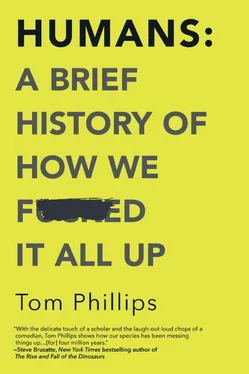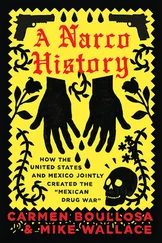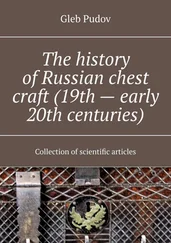Tom Phillips - Humans - A Brief History of How We F*cked It All Up
Здесь есть возможность читать онлайн «Tom Phillips - Humans - A Brief History of How We F*cked It All Up» весь текст электронной книги совершенно бесплатно (целиком полную версию без сокращений). В некоторых случаях можно слушать аудио, скачать через торрент в формате fb2 и присутствует краткое содержание. Город: Toronto, Год выпуска: 2019, ISBN: 2019, Издательство: Hanover Square Press, Жанр: История, Юмористические книги, на английском языке. Описание произведения, (предисловие) а так же отзывы посетителей доступны на портале библиотеки ЛибКат.
- Название:Humans: A Brief History of How We F*cked It All Up
- Автор:
- Издательство:Hanover Square Press
- Жанр:
- Год:2019
- Город:Toronto
- ISBN:978-1-48805-113-5
- Рейтинг книги:4 / 5. Голосов: 1
-
Избранное:Добавить в избранное
- Отзывы:
-
Ваша оценка:
- 80
- 1
- 2
- 3
- 4
- 5
Humans: A Brief History of How We F*cked It All Up: краткое содержание, описание и аннотация
Предлагаем к чтению аннотацию, описание, краткое содержание или предисловие (зависит от того, что написал сам автор книги «Humans: A Brief History of How We F*cked It All Up»). Если вы не нашли необходимую информацию о книге — напишите в комментариях, мы постараемся отыскать её.
Humans: A Brief History of How We F*cked It All Up — читать онлайн бесплатно полную книгу (весь текст) целиком
Ниже представлен текст книги, разбитый по страницам. Система сохранения места последней прочитанной страницы, позволяет с удобством читать онлайн бесплатно книгу «Humans: A Brief History of How We F*cked It All Up», без необходимости каждый раз заново искать на чём Вы остановились. Поставьте закладку, и сможете в любой момент перейти на страницу, на которой закончили чтение.
Интервал:
Закладка:
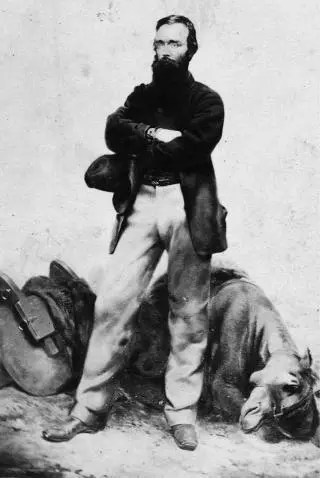
William Paterson, like many people whose lives have ended up firmly in the “losses” column of history, had a vision.
Not only did he have a vision; he had the skill and tenacity to convince others to go along with it. Paterson was a banker and financier by trade, but a salesman at heart: a man who seemed to combine the rigor of an actuary, the soul of a poet and the fiery conviction of a preacher in one irresistible package. It’s just a shame that his particular vision ended up with thousands dead and his home country of Scotland in financial ruin—and worse, at the mercy of its southern neighbor. In fact, without Paterson’s disastrous plans, the UK as we know it might not exist today.
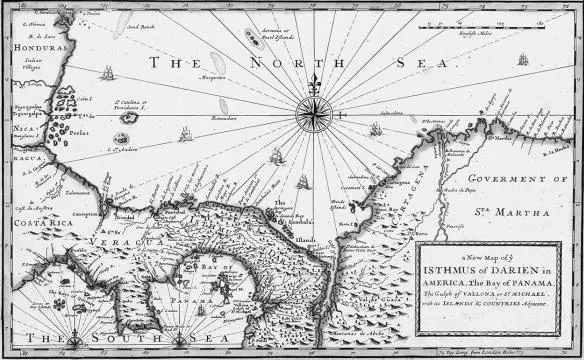
It’s a story of a country committing itself to grand but vague ambitions based on the proclamations of ideological true believers, of expert warnings not being listened to and of a stubborn refusal to acknowledge reality and change course, even when the world is sending you very clear signals that you might have made a mistake. (It’s also a story of the English being dicks, but that probably goes without saying.)
Paterson’s vision was of nothing less than a Scottish empire that would become the beating heart of global trade. And he knew exactly where he wanted the first outpost of that empire to be: a verdant paradise on the far side of the Atlantic Ocean, located at the fulcrum of the Americas. That place was called Darien.
Between 1698 and 1699, around 3,000 colonists set sail from Scotland, backed by a wave of nationalist sentiment and as much as half of the country’s wealth, giddy with the hope of finding Paterson’s paradise and founding that empire. Before the century was out, they’d discovered it was very much not a paradise, most of them were dead and the nation’s wealth might as well have been hurled into the waters of the Atlantic.
Now, in fairness to Paterson, not all of his visions were calamitous. In fact, one of his other visions lasts to this day—in 1691, he first proposed, and then in 1694 cofounded, the Bank of England. (And in case you’re wondering: a year after the Bank of England was founded by a Scotsman, the Bank of Scotland was founded by an Englishman.) In many ways, Paterson saw far earlier than most how the contours of globalized trade would shape the world we live in today. But he was both optimistic (“Trade is capable of increasing trade,” he wrote, “and money of begetting money to the end of the world”), and extremely stubborn. His attitude managed to piss off his fellow Bank of England directors sufficiently that he was forced to resign from the board less than a year after the bank was founded.
And so Paterson returned to the idea that had been something of an obsession for him for many years: a trading colony at Darien, on the eastern coast of the isthmus of Panama, the thin ribbon of land that formed the narrowest point of the American continent. Centuries before the building of the famous canal, it was already clear that Panama was where the journey from the Atlantic to the Pacific and back was easiest. Not easy , exactly, as the terrain was far from simple to traverse—but still quicker and safer than the perilous sea journeys via the southern tip of the Americas, around Cape Horn or through the Strait of Magellan. By connecting the two oceans, Paterson wrote with a melodramatic flourish, Darien would become the “door of the seas, and the key of the universe.”
This was during the early peak of Europe’s wild colonial expansion, and Scotland wanted in on the action. By the 1690s, the Spanish and the Portuguese had been absolutely coining it for the best part of two centuries on the resources they’d extracted from their American colonies; more recently, the English and the Dutch had joined the game to great success. The European scramble for global empires now covered Asia, Africa and the Americas, as the general strategy of “turn up with guns and take all their stuff” continued to promise untold riches, with no sign of slowing down.
The age of empire was also the age of financial revolution: as a result, much of the sharp end of colonialism was enacted not just directly by the states, but also by state-backed, publicly traded “joint-stock” companies that blurred the lines between mercantile business and geopolitics. These included infamous behemoths like the English East India Company and the Dutch East India Company, and it was this model that Paterson sought to broadly replicate for his Darien venture. These companies had a global reach, tremendous wealth and a level of power that outstripped that of many states. Indeed, the companies often acted like states in their own right, and wielded incredible influence over the government of their own countries. (So very unlike today.)
Additionally, the 1690s was also a time of uncertainty and doubt for Scotland. Ever since the Bible-commissioning witch-botherer James VI had gone south in 1603 and united the crowns of Scotland, England and Ireland into one, the Scots had been feeling restive. They were part of a union, yes, but still a politically independent nation: they had their own parliament, passed their own laws and still retained their own currency. However, the suspicion was growing among some segments of Scottish society that they were getting a raw deal from the whole business. The union of the crown, they believed (with some justification) was a stitch-up that acted only in the interests of the English; Scotland would always be the poorer cousin, and the diktats that were passed down from London would always favor the English capital to the detriment of Edinburgh.
These feelings were only increased by the fact that others were actively pushing for an ever closer union with England. And the heightened atmosphere was stoked even further by the financial turmoil of the 1690s—a monetary crisis in England, a king trying to pay for foreign wars and the “seven ill years” of recession, harvest failures and famine in Scotland that saw widespread starvation and the impoverishment of many. This economic crisis, rather than making the people of Scotland risk-averse, instead provided fertile ground for anybody with a promise to shake up the status quo. So when Paterson’s Darien scheme came along, it was seized on with patriotic fervor as a way for Scotland to reassert its independence, break free of the binds of the union and take control of its future.
Paterson didn’t actually conceive his scheme as a matter of national pride—in fact, he’d been trying to convince other countries to back it before he turned to his homeland. And even once it had become fixed as a Scottish venture in 1695 (as “The Company of Scotland Trading to Africa and the Indies,” backed by an act of the Scottish parliament that gave it a wide remit and ridiculously generous terms), he still began his efforts at raising funds for it in London. This is where it all started to go wrong—and where its founders first started to ignore the warning signs.
To begin with, though, things didn’t go wrong; in fact, they went very right. Too right, it turned out. Paterson’s reputation in London and his skills as a salesman, added to the unrestrained enthusiasm for joint-stock companies with global ambitions, meant that the Company of Scotland had no trouble finding backers, attracting pledges of investment totaling around £300,000—a vast sum. Unfortunately for them, such was the interest in their scheme that it couldn’t fail to attract the attention of the East India Company.
Читать дальшеИнтервал:
Закладка:
Похожие книги на «Humans: A Brief History of How We F*cked It All Up»
Представляем Вашему вниманию похожие книги на «Humans: A Brief History of How We F*cked It All Up» списком для выбора. Мы отобрали схожую по названию и смыслу литературу в надежде предоставить читателям больше вариантов отыскать новые, интересные, ещё непрочитанные произведения.
Обсуждение, отзывы о книге «Humans: A Brief History of How We F*cked It All Up» и просто собственные мнения читателей. Оставьте ваши комментарии, напишите, что Вы думаете о произведении, его смысле или главных героях. Укажите что конкретно понравилось, а что нет, и почему Вы так считаете.
